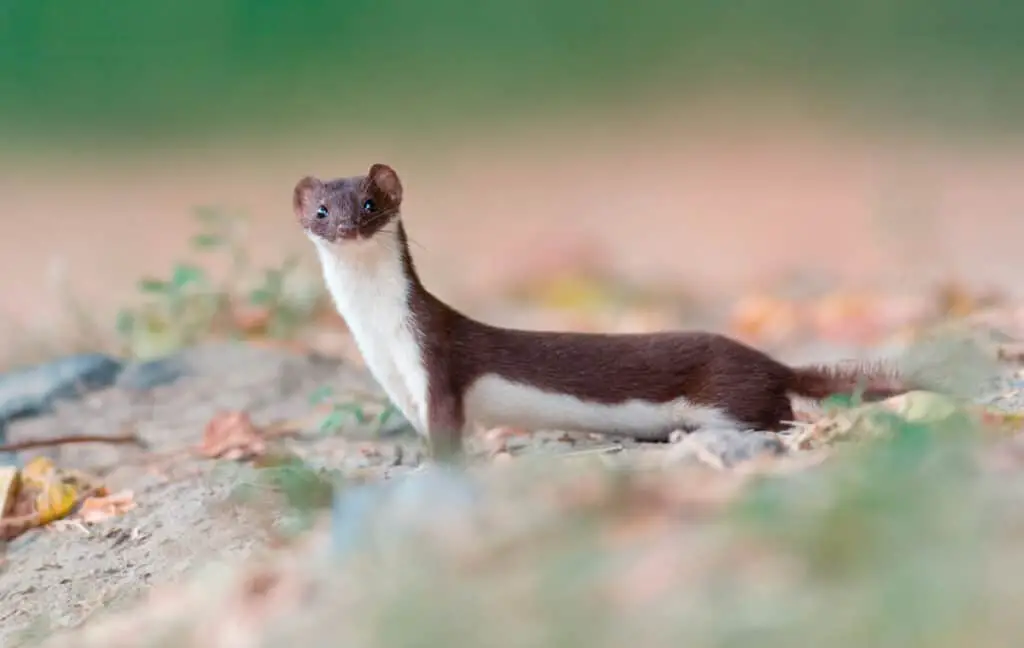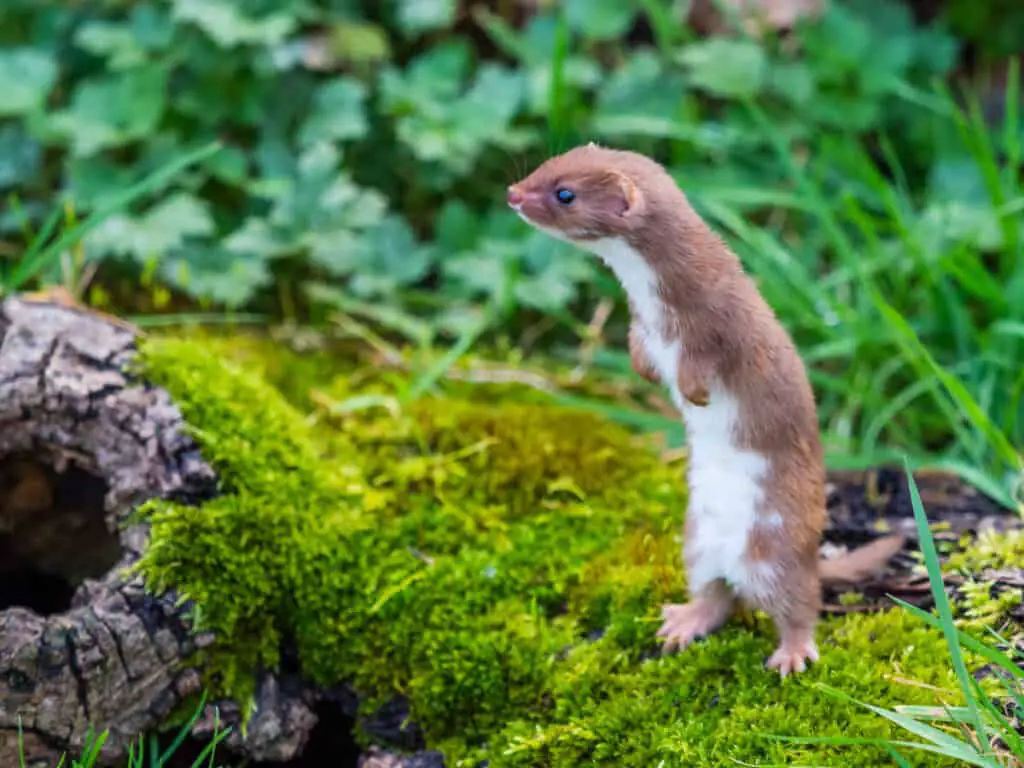Weasels are an important part of the natural order and have a unique lifecycle that is essential to their survival.
This article will explore the various stages in the life cycle of weasels, providing insight into their development from birth through adulthood.
It will also address how environmental changes can influence the species’ lifecycles, as well as any potential challenges they may face over time.
By understanding this process more fully, wildlife biologists can better assess weasel populations and make informed decisions about conservation efforts for these mammals.

Reproduction And Birth
Weasels are mammals that are known for their small size and carnivorous diet. They have a wide range in which they can be found, including North America, Europe, Asia, and some parts of Africa.
Breeding habits and mating rituals vary depending on the species but typically involve the female producing a litter of up to nine kits from one pregnancy. Males will compete with each other for dominance over females during breeding season. The male’s success is determined by his strength, agility, and speed compared to other males competing for the same mate.
After mating has occurred and the young weasel kits have been born, both parents take part in raising them until they reach maturity at approximately six months old when they leave home to establish their own territory.
Weasel’s Predators Revealed: Unmasking Their Natural Adversaries
Growth And Development
The birth of weasels marks the start of their growth and development. As they mature, weasels exhibit certain behaviors that enable them to survive in the wild, such as social behavior and habitat selection.
Weasel’s social behavior is characterized by territoriality where a single or multiple pairs of adults inhabit an area for mating purposes and defending against other animals. They communicate with different vocalizations such as screams, whistles, growls and purrs to indicate distress or contentment. Weasels also display aggressive behaviors towards intruders while hunting.
In terms of habitat selection, weasels’ preferences when it comes to food often dictate where they live; they usually select habitats near sources of prey like rodents, birds and insects. Additionally, these small carnivores prefer areas with adequate cover for protection from predators; this includes tall grasses, shrubs and logs.
Dens are essential elements in providing shelter from harsh weather conditions during winter months which can vary depending on geographical region.
Weasel Behavior Unveiled: Insights into Their Lives
Diet And Foraging
Weasels are versatile hunters that use a variety of foraging strategies to obtain food. They will hunt at all times of the day, but prefer dawn and dusk when most prey is active. Weasels can also climb trees in search of birds’ eggs or nestlings and take advantage of openings around buildings to catch small rodents. Furthermore, weasels have been known to eat carrion if other options are not available.
Food preferences vary widely depending on species; however, mice make up the majority of their diets. Other animals commonly eaten include voles, shrews, moles, rabbits and hares as well as birds and bird eggs. Additionally, some farmers report that weasels may occasionally feed on chickens or ducks kept in pens.
While they do consume insects such as caterpillars and beetles from time-to-time, these creatures play only an intermittent role in their diet.
In summary, weasel populations rely heavily upon small mammals as a primary source of sustenance.
Weasel Chronicles: Unraveling Their Unique Characteristics
Predators And Threats
Wild weasels are a highly adaptable species whose survival relies heavily on their ability to evade predators. As such, they have developed an intricate system of predator evasion and habitat selection strategies that has enabled them to persist in many different habitats around the globe.
The following points provide a brief overview of some of these strategies:
- Weasels employ camouflage techniques including color changes and postures designed to blend into their environment; this reduces their visibility while also allowing them to observe potential threats.
- Weasels have excellent hearing and smell which helps them detect danger from afar, prompting them to flee or hide before being detected by a predator.
- They select habitats with dense vegetation where they can seek shelter and find food more easily, reducing their chances of becoming prey.
Through such adaptive behaviors, wild weasels are able to survive in diverse ecosystems despite the presence of formidable predators. By understanding the unique set of skills possessed by weasels, wildlife biologists are better equipped to protect these animals as well as promote conservation efforts for other vulnerable species.
Weasels’ Whispers: Exploring Their Vocalizations

Adaptation And Survival
Weasels, small carnivorous mammals belonging to the Mustelidae family, have a complex lifecycle consisting of various adaptations and survival strategies. Migration patterns are one way they survive throughout their short lives. Weasels migrate in search of food during winter months when resources become scarce, often traveling up to several miles per night. They also move seasonally in order to select suitable habitats for mating purposes.
Habitat selection is important for weasel reproduction and affects the success of offspring production. Table 1 provides an overview on certain features that play a role in habitat selection by weasels. These include adequate cover from predators or inclement weather, access to prey populations, and potential mates within close proximity. As can be seen from the table below, location plays a key factor in successful breeding outcomes for this species.
Table 1: Features influencing Habitat Selection
| Feature | Description |
|---|---|
| Cover | Adequate coverage from predators or inclement weather |
| Prey Availability | Accessible areas with abundant prey populations nearby |
| Mates Proximity | Close vicinity of potential mates creating opportunities for effective breeding behavior |
Overall, weasels use different strategies such as migration patterns and habitat selection throughout their life cycle to help ensure their own survival and that of future generations.
Conclusion
The life cycle of the weasel is as fascinating and varied as its habitats.
Reproduction begins with mating season in early spring, followed by a gestation period of 30–35 days.
After birth, young weasels grow rapidly, reaching an average adult size within one year.
Weasels are opportunistic feeders, consuming small rodents and birds as well as vegetation in their diet.
Predators such as foxes, hawks, and owls can threaten them; however, they have several adaptations that help them survive including agility and speed which allow for quick escapes from predators.
Interestingly, weasels can also dive underwater to catch fish or escape danger – staying submerged for up to two minutes!
This remarkable adaptation demonstrates how adaptable these animals are to their environment.
With a carefully balanced diet and natural defenses against predators, the lifecycle of the weasel is ensured over generations to come.

